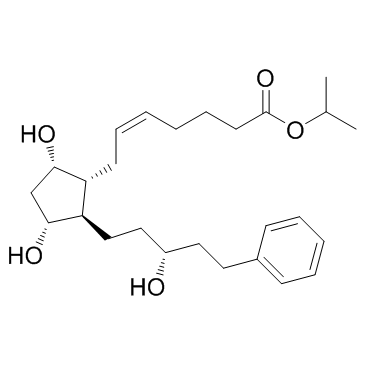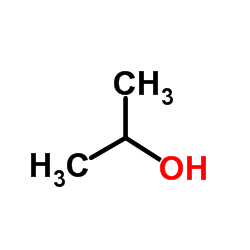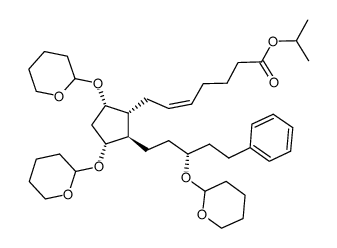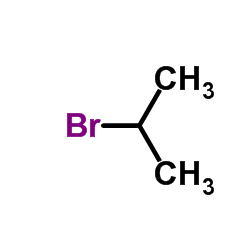Latanoprost

Latanoprost structure
|
Common Name | Latanoprost | ||
|---|---|---|---|---|
| CAS Number | 130209-82-4 | Molecular Weight | 432.593 | |
| Density | 1.1±0.1 g/cm3 | Boiling Point | 583.8±50.0 °C at 760 mmHg | |
| Molecular Formula | C26H40O5 | Melting Point | N/A | |
| MSDS | Chinese USA | Flash Point | 188.3±23.6 °C | |
Use of LatanoprostLatanoprost is an agonist for the FP prostanoid receptor, and lowers intraocular-pressure (IOP). |
| Name | latanoprost |
|---|---|
| Synonym | More Synonyms |
| Description | Latanoprost is an agonist for the FP prostanoid receptor, and lowers intraocular-pressure (IOP). |
|---|---|
| Related Catalog | |
| Target |
FP Receptor |
| In Vitro | Benzalkonium chloride latanoprost (BAK-latanoprost) and 0.02% BAK induce significant apoptosis in the apical layers that correlated with the significant decrease of cell viability. Preservative-free latanoprost (PF-latanoprost) slightly decreases cell viability and few apoptotic cells are found in the superficial layers, without reaching statistical significance compared with PBS[1]. Latanoprost (0.1 μM) significantly increases cell viability as compared with control. Meanwhile, 0.1 μM latanoprost results in the obvious promotion of neurite outgrowth similar to ciliary neurotrophic factor (CNTF) and simultaneously increases the levels of p-Akt and p-mTOR expression. Latanoprost can promote neurite outgrowth through an FP receptor-mediated modulation of the PI3K-Akt-mTOR signaling pathway[3]. Latanoprost (0.03 or 0.3 μg/mL) and bimatoprost increase MMP-9 activity by 75% ± 27% and 75% ± 24%, respectively, in human CBSM cells[4]. |
| In Vivo | A single drop of latanoprost results in marked miosis, anterior bowing of the peripheral iris, narrowing of the iridocorneal angle, and shallowing of the anterior chamber of the beagle dog. Following latanoprost, the pupil diameter, ACA, and AOD (means) decreases 84%, 14%, and 16%, respectively[2]. |
| Cell Assay | Cellular viability is evaluated in duplicate at 24 hours with the MTT assay. The 3D-HCEs are transferred to 24-well plates containing 300 μL of MTT solution diluted at 0.5 mg/mL in the culture medium, and 300 μL of the same MTT solution is applied on the apical surface of the 3D-HCEs. Reconstituted tissues are incubated for 3 hours at 37°C. Then they are transferred to 24-well plates containing 750-μL isopropanol, and 750-μL isopropanol is added to the apical surface of the 3D-HCEs. The plates are agitated for 2 hours at room temperature before reading the optical density (OD) at 570 nm versus OD 690 nm. The results are expressed as percentages of cell viability (mean ± SD) compared with the negative control (PBS). |
| References |
| Density | 1.1±0.1 g/cm3 |
|---|---|
| Boiling Point | 583.8±50.0 °C at 760 mmHg |
| Molecular Formula | C26H40O5 |
| Molecular Weight | 432.593 |
| Flash Point | 188.3±23.6 °C |
| Exact Mass | 432.287567 |
| PSA | 86.99000 |
| LogP | 3.65 |
| Vapour Pressure | 0.0±1.7 mmHg at 25°C |
| Index of Refraction | 1.538 |
| InChIKey | GGXICVAJURFBLW-CEYXHVGTSA-N |
| SMILES | CC(C)OC(=O)CCCC=CCC1C(O)CC(O)C1CCC(O)CCc1ccccc1 |
| Storage condition | −20°C |
| Water Solubility | DMSO: freely soluble |
| Personal Protective Equipment | Eyeshields;Faceshields;Gloves;type N95 (US);type P1 (EN143) respirator filter |
|---|---|
| RIDADR | NONH for all modes of transport |
| WGK Germany | 3 |
| RTECS | MJ9669550 |
| HS Code | 2937500000 |
| HS Code | 2937500000 |
|---|
|
Translating clinical findings into knowledge in drug safety evaluation--drug induced liver injury prediction system (DILIps).
J. Sci. Ind. Res. 65(10) , 808, (2006) Drug-induced liver injury (DILI) is a significant concern in drug development due to the poor concordance between preclinical and clinical findings of liver toxicity. We hypothesized that the DILI typ... |
|
|
Effects of K-115, a rho-kinase inhibitor, on aqueous humor dynamics in rabbits.
Curr. Eye Res. 39(8) , 813-22, (2014) To evaluate the topical instillation of K-115, a selective Rho-associated coiled coil-containing protein kinase (ROCK) inhibitor, on intraocular pressure (IOP), ocular distribution, and aqueous humor ... |
|
|
COX-2 inhibition improves retinal function in rats' ischemic eyes.
J. Ocul. Pharmacol. Ther. 30(8) , 634-41, (2014) Retinal ischemia is a relatively simple model for studies in pharmacological neuroprotective intervention. The role of cyclooxygenase (COX) enzymes in ischemic insult has been variously shown to eithe... |
| 13,14-Dihydro-17-phenyl-18,19,20-trinor-PGF2a-isopropyl Ester |
| 5-Heptenoic acid, 7-[(1R,2R,3R,5S)-3,5-dihydroxy-2-[(3R)-3-hydroxy-5-phenylpentyl]cyclopentyl]-, 1-methylethyl ester, (5Z)- |
| Lata prostaglandin |
| Xalatan |
| 1-Methylethyl-(5Z)-7-{(1R,2R,3R,5S)-3,5-dihydroxy-2-[(3R)-3-hydroxy-5-phenylpentyl]cyclopentyl}hept-5-enoat |
| Isopropyl (5Z)-7-{(1R,2R,3R,5S)-3,5-dihydroxy-2-[(3R)-3-hydroxy-5-phenylpentyl]cyclopentyl}hept-5-enoate |
| phxa41 |
| Latanoprost |
| MFCD00216074 |
| (5Z)-7-{(1R,2R,3R,5S)-3,5-dihydroxy-2-[(3R)-3-hydroxy-5-phénylpentyl]cyclopentyl}hept-5-énoate de 1-méthyléthyle |
| xa41 |
| Propan-2-yl-(5Z)-7-{(1R,2R,3R,5S)-3,5-dihydroxy-2-[(3R)-3-hydroxy-5-phenylpentyl]cyclopentyl}hept-5-enoat |
| LATANAPROST |
| propan-2-yl (5Z)-7-{(1R,2R,3R,5S)-3,5-dihydroxy-2-[(3R)-3-hydroxy-5-phenylpentyl]cyclopentyl}hept-5-enoate |
| Xalata |
| [1R-[1a(Z),2b(R*),3a,5a]]-7-[3,5-Dihydroxy-2-(3-hydroxy-5-phenylpentyl)cyclopentyl]-5-heptenoic Acid 1-Methylethyl Ester |
| Isopropyl (5Z)-7-{(1R,2R,3R,5S)-3,5-dihydroxy-2-[(3R)-3-hydroxy-5-phenylpentyl]cyclopentyl}-5-heptenoate |
| 1-methylethyl (5Z)-7-{(1R,2R,3R,5S)-3,5-dihydroxy-2-[(3R)-3-hydroxy-5-phenylpentyl]cyclopentyl}hept-5-enoate |
| Isopropyl (Z)-7-[(1R,2R,3R,5S)-3,5-dihydroxy-2-[(3R)-3-hydroxy-5-phenylpentyl]cyclopentyl]-5-heptenoate |
 CAS#:75-30-9
CAS#:75-30-9 CAS#:41639-83-2
CAS#:41639-83-2 CAS#:67-63-0
CAS#:67-63-0 CAS#:856453-33-3
CAS#:856453-33-3 CAS#:75-26-3
CAS#:75-26-3